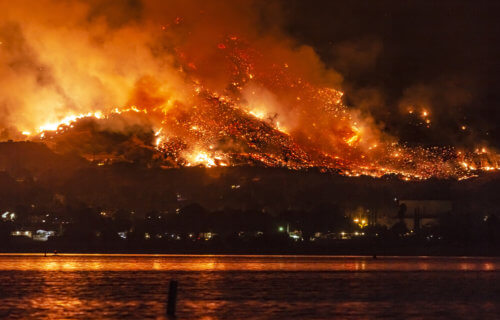BOULDER, Colo. — Wildfires continue to ravage west coast states, leaving forests and residential neighborhoods devastated in their wake. Stunning images of Mars-like skies continue to consume social media. The past few years have seen some particularly devastating blazes tear through California, Oregon, and Washington. Now, a near unbelievable new study finds that 97% of the wildfires that have threatened U.S. homes over the past 28 years have been started by people.
How were these conclusions reached? Researchers from the University of Colorado at Boulder use an innovative new analysis that combines both housing and wildfire data. This process led them to conclude that the vast majority of home-threatening wildfires are started by activities like equipment use, debris clearing, and arson.
In addition to all that, the study’s authors also report that one million homes have “sat within the boundaries” of wildfires over the past 24 years. That’s far more than official estimates, mostly because this time around researchers included smaller fires.
Close to another 59 million homes located within the “wildland-urban interface” have been within .6 miles of a wildfire at some point as well.
“We have vastly underestimated the wildfire risk to our homes,” says lead study author Nathan Mietkiewicz, who led the research as a postdoc in Earth Lab, part of CIRES at the University of Colorado Boulder, in a release. “We’ve been living with wildfire risk that we haven’t fully understood.”
‘Wildfire problem not going away anytime soon’
Researchers combed through an enormous collection of data for this project. First, they gained access to 1.6 million government spatial records regarding wildfire ignition between 1992-2015. Not to mention another 120,000 incident reports provided by Earth Lab and 200 million housing records from Zillow.
“Our fire problem is not going away anytime soon,” cautions study co-author Jennifer Balch, director of Earth Lab, a CIRES Fellow, and an associate professor of geography. Balch says that climate change is playing a big role in all of this by creating warmer, drier conditions all over the country.
The study also finds that humans have caused 97% of all fires within the wildland-urban interface, 85% of all fires in “very-low-density housing” areas, and 59% of all wildfires in wildlands areas between 1992-2015.
Making matters worse, human-started fires are more expensive to fight than other fires. It’s estimated that man-made fires account for one third of firefighting expenses. In fact, about half of all fire suppression costs are spent on protecting houses.
‘Prescribed burns can mitigate risk, threat’
The wildland-urban interface, or WUI, only represented 10% of U.S. land in 2010, but 32% of all wildfires take place there. Moreover, more and more people are building homes within the WUI. Between 1992 and 2015, 32 million new homes were built there.
“This provides greater justification that prescribed burns, where safe, can mitigate the risk and threat of future wildfires,” Balch adds. “We essentially need to build better and burn better.”
“Smokey Bear needs to move to the suburbs,” Mietkiewicz concludes. “If we can reduce the number of human-caused ignitions, we will also reduce the amount of homes threatened by wildfires.”
The study is published in Fire.
